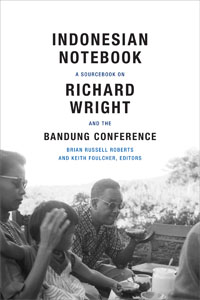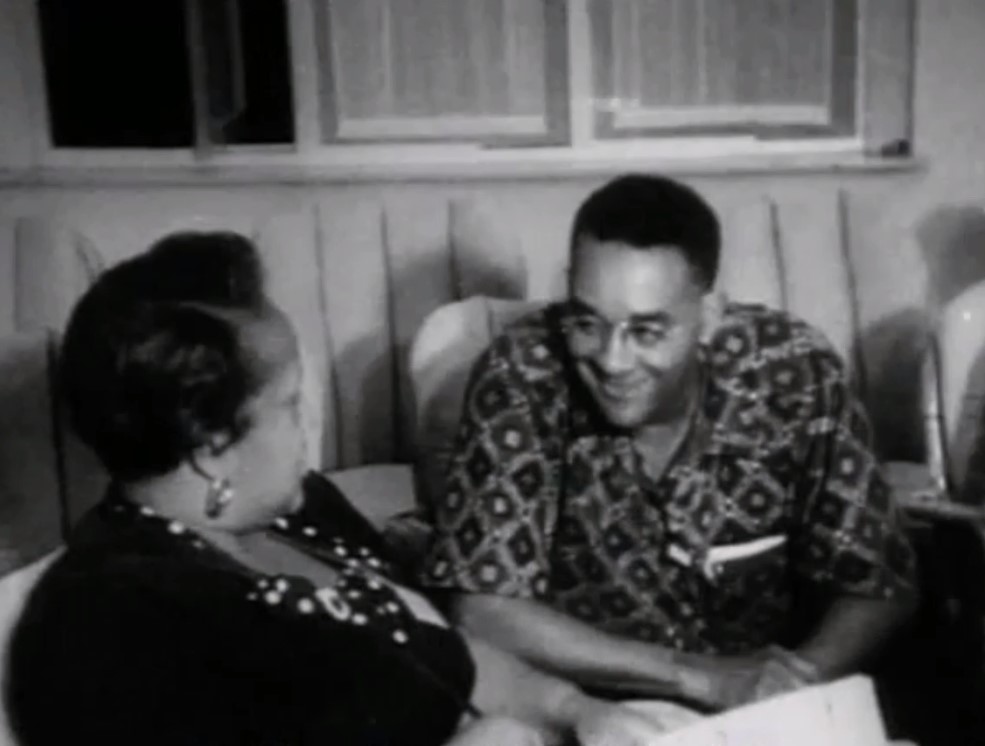
Wright wearing a traditional Indonesian batik shirt at the Bandung Conference, seated with fellow African American reporter Ethel Payne. Film still from “Konperensi Asia Afrika” (1955), produced by Indonesia’s government-owned film company, Perusahaan Film Negara. Courtesy of Arsip Nasional Republik Indonesia.
Richard Wright and Indonesia
The year 2015 marked the sixtieth anniversary of the 1955 Asian-African Conference, a gathering of representatives from twenty-nine newly independent Asian and African countries. Often called the Bandung Conference because it was held in the Indonesian city of Bandung, this gathering has been regarded as a key forerunner of the Non-Aligned Movement and a foundational moment in postcolonial history. Major international leaders spoke at the conference from April 18 to 24, including Zhou Enlai of China, Carlos Romulo of the Philippines, Soekarno of Indonesia, Nehru of India, and Nasser of Egypt. Over four hundred reporters attended, describing everything from the delegates’ speeches to Bandung street scenes.
One of the most internationally famous of those reporters was Richard Wright. Highly acclaimed for his 1940 novel Native Son and his 1945 memoir Black Boy, Wright had moved to Paris in 1947, seeking to escape continuing and intolerable racial discrimination; it was here, self-exiled in Paris in December 1954, that he read the announcement of a conference in Bandung, poised to address international “racialism and colonialism.” According to his memory of this occasion as relayed in The Color Curtain, Wright was immediately struck by the similarities between his own life experiences—especially his experience of race, class, and religion—and those of the Bandung Conference participants. Sensing his excitement, Wright’s wife, Ellen Poplar, said, “If you feel that way, you have to go.” The Color Curtain was the outcome of his Indonesian travels, and during the six decades since its publication this book has emerged as a major source of information and perspective on the conference and its significance.
And yet, as deservedly important as Wright’s English-language discussions of the conference have become, admirers and scholars of Wright have known almost nothing about the Indonesian-language archive surrounding Wright’s three-week Indonesian sojourn, from April 12 through May 5. In an attempt to fill this gap, we spent the year of the Bandung Conference’s sixtieth anniversary putting the finishing touches to a book that has been some seven years in the making. Titled Indonesian Notebook: A Sourcebook on Richard Wright and the Bandung Conference, it offers translations of dozens of Indonesian-language documents discussing Wright’s activities in Indonesia, ranging from newspaper articles to book reviews and interviews. Indonesian Notebook provides substantive introductions to these translated materials, almost all of which have, until now, remained absent from the extensive published documentation of Wright’s life. His biographers have produced at least nine substantial biographies, and his bibliographers have sought to list all items (published and unpublished) written by Wright, along with all items written about him. Additionally, speaking to the extraordinary thoroughness of research on Wright’s life and writings, recent years have seen the publication of The Richard Wright Encyclopedia (2008) and Richard Wright: A Documented Chronology, 1908–1960 (2013), which gives a date-by-date, cradle-to-grave outline of Wright’s life.
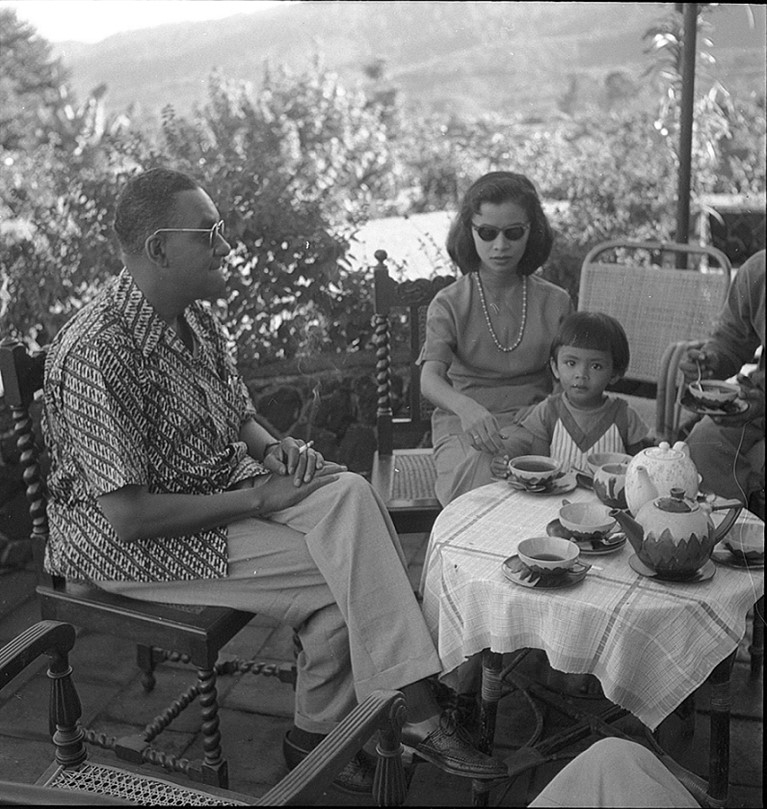
Wright with participants in the Konfrontasi Study Club, 1955. Pictured here, left to right: Richard Wright, Siti Nuraini, Fedja (daughter of Siti Nuraini and Asrul Sani), and Sitor Situmorang (arm only). Photographer unknown. Courtesy of the Beinecke Rare Book and Manuscript Library, Yale University.
Given this high level of documentation, we were surprised to be able to find new information on Wright’s lecturing activities in Indonesia. In the Indonesian daily press, we found two newspaper articles quoting from a brief talk Wright gave at the home of Jakarta’s mayor. Also in the daily press, we found a photograph of Wright being introduced to a group of students who had gathered to hear him talk. Elsewhere, we found the published text of a lecture titled “American Negro Writing,” which Wright delivered to a meeting of a study club associated with an Indonesian cultural affairs journal of the day. “American Negro Writing” is the first known English-language publication of Wright’s oft-cited lecture “The Literature of the Negro in the United States,” which was originally published in French in 1948 and which re-appeared in English in 1957, in his lecture collection White Man, Listen!. Its first English publication, in an Indonesian journal in 1955, was accompanied by an Indonesian-language synopsis and commentary, which we have included in our collection of translated documents.
On the Trail of Wright’s Forgotten Lecture
But perhaps our most surprising and significant find was still another lecture, one that has remained almost unknown within the exceptionally thorough arena of Wright scholarship. In the daily press, we had read a brief mention of a lecture Wright gave on May 2 for PEN Club Indonesia and Indonesia’s Council for Deliberations on National Culture (BMKN). In looking for information on this lecture, we searched through every relevant Indonesian periodical we could find, including the newspaper Indonesia Raya, whose editor-in-chief was Mochtar Lubis, Wright’s host during his three-week stay in Indonesia. No new information surfaced, however, until our friend and colleague Paul Tickell came to our aid in November 2011. Generously devoting some of his own research time in Jakarta to looking through the Indonesian National Library’s holdings of Indonesia Raya over a longer time frame than we ourselves had so far managed to do, Paul quickly came upon an Indonesian translation of Wright’s PEN Club/BMKN lecture, published in Indonesia Raya on May 22, 1955, two and a half weeks after Wright left Indonesia. Titled “Seniman dan Masalaahnja,” the text of the lecture appeared to be incomplete, but no further installment was to be found. Brian’s subsequent searches in the same library in May 2013 failed to uncover any more of its content, either elsewhere in the May 22 issue of Indonesia Raya or in later issues.
A year after Brian’s follow-up research in Jakarta, we received additional help from an unexpected quarter. Already involving trans-Pacific research collaboration between the United States, Australia, and Indonesia, our network took on a connection with Japan, when Wright scholar Toru Kiuchi helped us locate a typewritten draft of some lecture notes held among the Richard Wright Papers in Yale University’s Beinecke Library. Wright left these notes untitled, but the Beinecke has the typescript filed under the heading “[On Writers and their Art].” This document has remained virtually unreferenced by scholars, and when it has been cited, it has been misunderstood as a lecture Wright gave in Bandung, or the transcript of an interview with Wright in the same city. When we compared it with the Indonesian text published in Indonesia Raya, it was clear that these notes were a longer version of the same text, the basis of the English-language lecture Wright delivered in Jakarta on May 2, 1955.
After the Wright Estate kindly granted permission for us to include a version of this lecture in Indonesian Notebook, we set about comparing the two versions and thinking about the problems involved in back-translating the Indonesian-language version into English. In what ways should our back-translation be accountable to the lecture’s Indonesian version, which had been its only previous publication? And in terms of Wright’s English-language lecture notes, should we consider these to constitute “the original” lecture? On one hand, if we were attempting to provide readers with access to how Wright’s Indonesian audience would have understood the lecture, leaning on the Indonesian translation would be important. But if we were attempting to provide readers with a representation of what Wright intended to say, perhaps it would be best to prioritize the version of the lecture contained in his typewritten notes? How might we go about producing a translation that reflected both Wright’s draft for the lecture and the text that was presented to an Indonesian audience and published in a major Indonesian newspaper?
As we continued comparing the two documents, we found ourselves in a situation that upended any sense that we were dealing with a paired “original” and “translation.” This was a situation that seemed, literally, to instantiate Jorge Luis Borges’s often-quoted observation, “The original is unfaithful to the translation.” It had been clear from the outset that Wright’s English-language notes contained several passages that were not included in the Indonesian translation, but as we began our own translation work, we also realized that the lecture’s Indonesian version contained a smaller number of phrases and passages, such as a reference to Wright’s recent travel in Africa, that were absent in the English-language notes. Although the two versions often corresponded to each other on a sentence-by-sentence basis (if not a word-for-word basis), we were nonetheless dealing with discrepancies that we could not ignore. The translation process, always so much more than simply the conversion of words and sentences from one language to another, required us to consider scenarios that might have produced these differences. We hypothesized that we were dealing with a case in which the Indonesian version had been translated from a now-absent source text, a document that was a revision, or later version, of the English-language notes. This now-absent revision, we surmised, would have remained in Indonesia with an Indonesia Raya editor while the English-language notes that we now had access to would have returned with Wright to Paris, eventually finding their way into the Wright collection at Yale’s Beinecke Library.
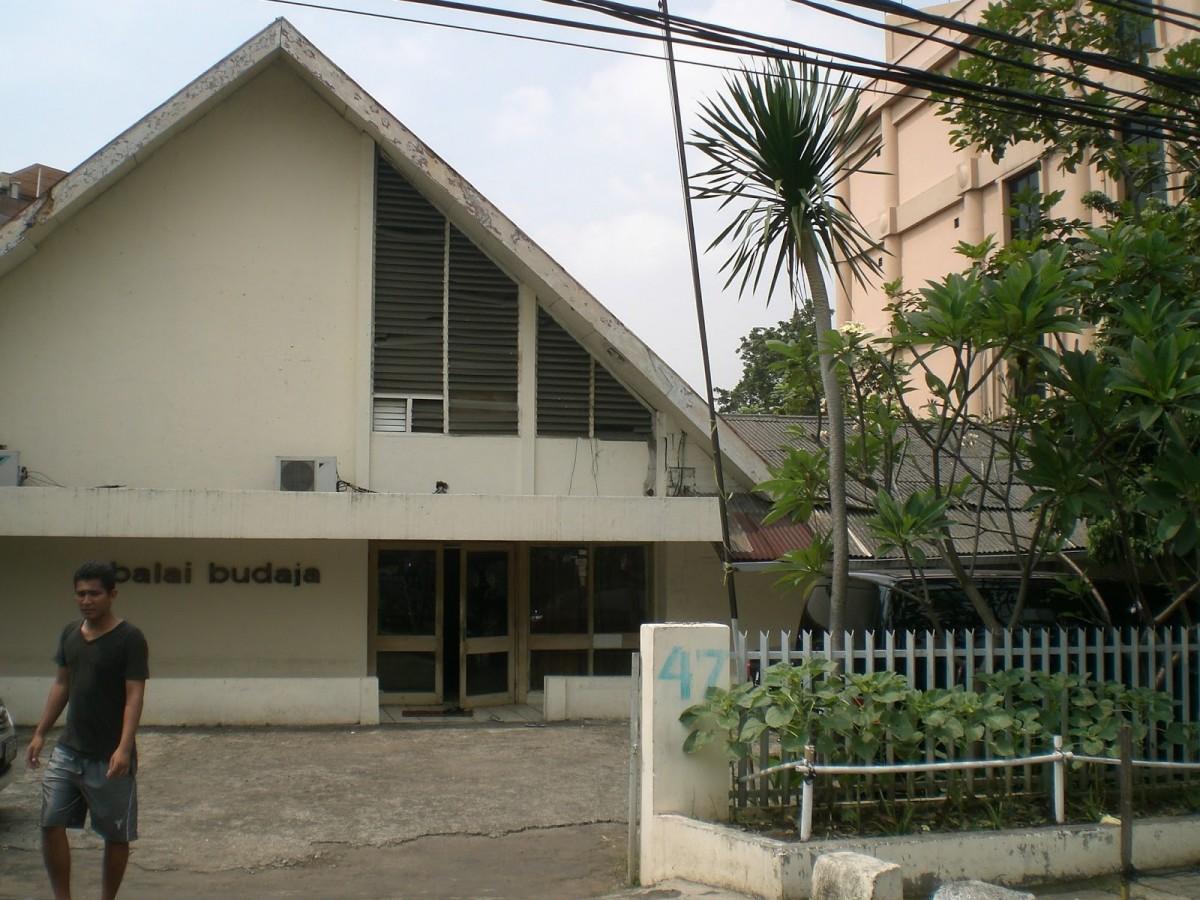
Exterior of the Balai Budaja in 2013, venue of Wright’s 2 May 1955 lecture “The Artist and His Problems.” Photograph by Brian Russell Roberts, May 2013.
Having alighted on this explanation as our working solution, we set about making decisions on how to balance the English notes and the Indonesia Raya publication to produce a reconstituted version of the lecture in English. At the same time, however, we continued thinking about the problems involved in the cultural translation of the lecture, from its 1950s Indonesian context to the sphere of an international audience, sixty years later, accustomed to living in what Japanese novelist Minae Mizumura has described as “the age of English.” To make the transition from the local context to a general contemporary readership in English, we felt we needed to understand more about the circumstances that had generated our two source texts. We tried to imagine the setting in which Wright delivered his lecture in Jakarta. How many people might have been present? Who were they, and what were their backgrounds? What might they have understood of Wright’s lecture when it was spoken in English and when it found print in Indonesian? In approaching these issues of cultural translation, we were aided by a conversation Brian had arranged in Jakarta in 2013 with Ajip Rosidi, a senior Indonesian author and cultural figure who attended Wright’s PEN Club/BMKN lecture in 1955 as a seventeen-year-old aspiring writer. Ajip recalled that during the mid-1950s, a lecture at the Balai Budaja would have been attended by about thirty people, and he believed that on this occasion, everyone in the audience shook Wright’s hand at the event’s conclusion. He further recalled having invited Wright to come and stay with him at his simple home, with its earthen floors and woven bamboo walls, because he believed Americans should see how ordinary Indonesians were living in Jakarta. When asked what he remembered of the lecture itself, Ajip recalled that he could not follow all of it because it was delivered in English. However, thinking back across nearly six decades, he believed that Mochtar Lubis translated it into Indonesian so non-English-speakers could understand.
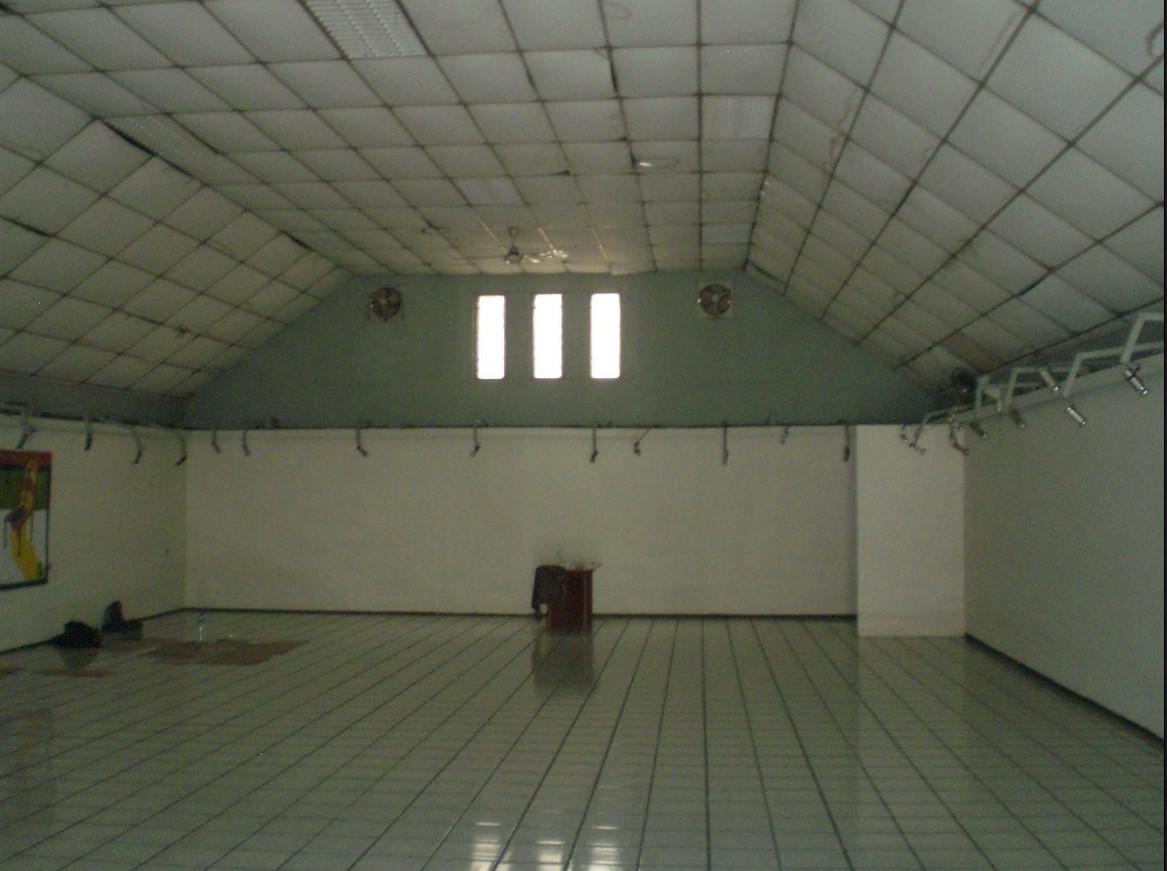
Interior of the Balai Budaja, where about thirty members of PEN Club Indonesia and the BMKN gathered to hear Wright’s 2 May 1955 lecture. Photograph by Brian Russell Roberts, May 2013.
Ajip’s commentary furthered our efforts in cultural translation because his recollection seemed consistent with our working assumption regarding a now-lost source text for the lecture’s translation in Indonesia Raya. It made the hypothetical scenario seem considerably more vivid in our minds: At some point between the conclusion of the Bandung Conference on April 24 and Wright’s May 2 lecture in Jakarta, Wright typed up some lecture notes and showed them to Mochtar. Based on Mochtar’s knowledge of audience interest and understanding, and, importantly, the lecture’s potential for translation into fluent and easily understood Indonesian, Mochtar may then have suggested that Wright make some revisions. As Mochtar knew, the English-speakers in Wright’s Indonesian audience would have spoken English as a second, or more likely third or fourth language (after their own regional language, the Indonesian national language, and—among the older generation—Dutch), and some in the audience would have spoken little or no English. Under these circumstances, it is likely that Mochtar suggested that it would be best if he himself provided a running Indonesian translation of the lecture as Wright gave it. Based on such a suggestion, Wright may have prepared a revised set of notes to hand over to Mochtar for translation ahead of time. This scenario would explain some of the differences between the two versions of Wright’s lecture, because the sections of Wright’s notes that are elided from the version published in Indonesia Raya, as well as the smaller number of additions to Wright’s notes in the Indonesian version, are consistent with an adaptation of Wright’s lecture to make it more easily digested, and perhaps more palatable, to a gathering of Indonesian writers, artists, and intellectuals in mid-1950s Jakarta. This adaptation itself—whether performed by Wright, Mochtar, or someone else—might be viewed as the cultural translation that preceded Indonesia Raya’s English-to-Indonesian translation.
A Reconstituted Asian-African Lecture
In preparing our English-language version of the lecture for inclusion in Indonesian Notebook, our main aim was to give readers access to the way Wright’s Indonesian audience would have understood him in 1955. Hence, we began by making a back-translation, relying on Indonesia Raya’s Indonesian-language version as we brought the lecture back into English. Yet we were also mindful of Wright’s own diction, and we carefully compared our back-translation to Wright’s notes, working to integrate the notes’ English words and phrases whenever this was consistent with our understanding of the lecture’s meaning as it was documented in Indonesia Raya. As an aid to Wright scholars and individuals interested in the translation process, we used explanatory notes to discuss where and how the two versions depart from each other in significant ways. Finally, wherever the Indonesia Raya version of the lecture did not include material contained in Wright’s typescript notes, we reinserted the elided material and marked it with italics. In reinserting this material from Wright’s unrevised notes, we hoped the translation would preserve a sense of Wright’s own voice, consistent with his statement on preparing to publish his 1957 collection White Man, Listen!: “In these pages . . . I’ve deliberately preserved the spoken tone.”
Choosing a title for our English version of the lecture presented some dilemmas. As mentioned earlier, the Beinecke designates Wright’s untitled lecture notes as “[On Writers and their Art].” But this title does not convey the lecture’s Indonesian title, “Seniman dan Masalaahnja,” which, due to the gender neutrality of third-person pronouns in Indonesian, can be literally translated as “The Artist and Her/His Problems.” Although as translators in the twenty-first century it would have been our preference to shift the title’s translation to “Artists and Their Problems,” we felt the title should be accountable to Wright’s typescript (where, consistent with standard 1950s English usage, the idealized artist is singular and always a “he”). As a result, in our translation, the literal “The Artist and Her/His Problems” becomes simply “The Artist and His Problems.” As for our decision to keep the slightly awkward word problems rather than rely on the Beinecke’s more elegant word art, this is neither unintended translationese nor an intentional effort at what Lawrence Venuti has called “foreignizing translation.” Rather, it is a reflection of the fact that Indonesia Raya’s Indonesian translation of Wright’s introductory remarks includes the phrase seniman, dan masaalah²nja, a near-verbatim echo of the Indonesian title (the superscript 2 was a convention indicating plurality in written Indonesian at this time). The direct equivalence between the Indonesian masaalah and the English problem suggests that Wright used the term problems when he addressed his audience in English.
This reconstituted document, a version of which was delivered during Wright’s trip to Indonesia for the Bandung Conference, may be described as an Asian-African lecture. Specifically geared toward an Indonesian audience whose country had just witnessed the excitement of the Asian-African Conference, the lecture describes the materiality of a writer’s experience in the contemporary Western world, as if to offer insight to Indonesians as they themselves grappled with the question of cultural production under the conditions of modernity. Along these lines, Wright addresses the modern writer’s lack of a defined audience, the rise of the novel as imbricated with the middle class, and the challenges involved in making a living while balancing the competing demands of aesthetic commitment and the commercial publishing industry. The lecture also offers remarks on the creative process that Indonesian modernists in Jakarta would have found particularly germane to their own discussions at the time, especially as they, like Wright, were concerned with where to look for artistic inspiration and the question of negotiating political and moral commitments in literary art.
The lecture indicates that, in thinking through these issues, Wright was doing so in the context of his perceptions of Asia-Africa. In 1953 Wright had visited the Gold Coast, and now, in Indonesia, he had also been afforded a glimpse of postcolonial Asia. In “The Artist and His Problems,” we see him drawing on both these sets of experiences. For example, in discussing the problem of temporality as an element in art, Wright wades into the debates on a supposed “crisis” in Indonesian literature that were then current in Jakarta, sharing his observations on the perception of time in the Gold Coast and its relation to the development of the novel in non-Western contexts. Elsewhere, in discussing politics’ relation to art, Wright cites Chinese Premier Zhou Enlai’s commentary on atheism during his Bandung Conference speech. Also on the problem of politics and art, Wright discusses national leaders’ decisions to modernize by means of force, an observation no doubt partially inspired by his intersection with Asian-African leaders in Bandung, and which presages his remarks, later included in his four-lecture collection White Man, Listen!, on the “quasi-dictatorial methods” that Soekarno, Nehru, Nasser, and Kwame Nkrumah may use “to hasten the process of social evolution and to establish order in their lands.” Indeed, given its themes, we would frame “The Artist and His Problems” as a lost fifth lecture from the era of White Man, Listen!, permitting new insight into Wright’s developing views on Asian-African affinities and East-West tensions.
In 1955, this Asian-African lecture found translation into Indonesian because it was given by a famous writer of the English-speaking world. Six decades later, it might be argued, the lecture has been back-translated into English because Wright is still a famous writer of the English-speaking world. But the lecture, translated into Indonesian and back-translated into English, points toward a much more extensive Asian-African archive produced by writers who have not written in English. Beyond simply reconstituting Wright’s lost Asian-African lecture, Indonesian Notebook offers English translations of writings by many Indonesian modernists who also grappled with the question of a world without empire. These modernists of postcolonial Indonesia respected Wright but were sometimes puzzled by his representations of Indonesia and of themselves. And their writings, which in Indonesian Notebook take up the questions of race and colonialism that Wright was considering during his trip to Southeast Asia, showcase one facet of the rich diversity of thought and political stances held among postcolonial intellectuals of the mid-twentieth century. In this way, the book reaches out beyond its core concerns with Richard Wright and the Bandung Conference to point toward the vast, non-English, Asian-African archive that is of such crucial importance to the writing of postcolonial history.

